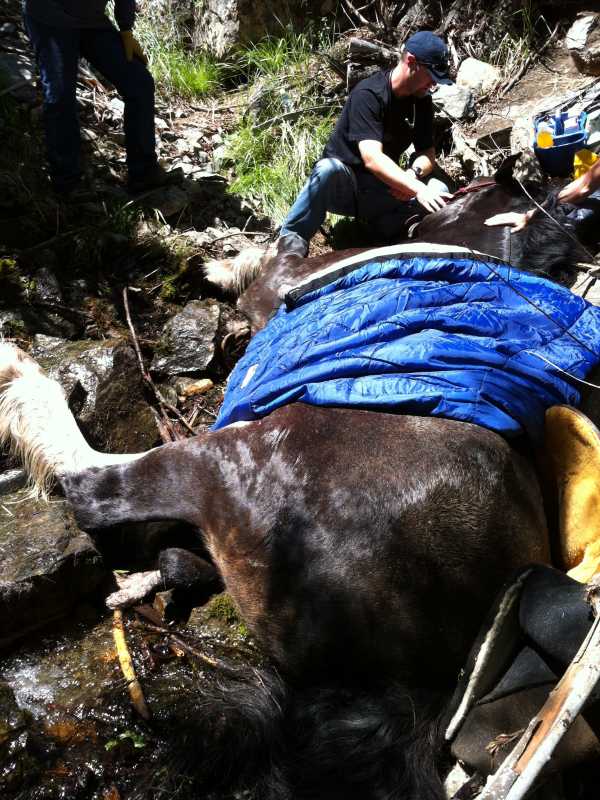|
I'll start with a personal comment. Since doing this stuff since the early 1980s, this was the most complex large animal extrication that I have ever seen. There were not only what seemed to be an endless series of impediments, but many of those impediments were daunting and physically challenging. The extrication required the joint efforts of the Carson City Fire Dept., Sheriff's Department, Search and Rescue, Public Works and rescue volunteers.
On arrival the large animal team was advised that the horse had been down in the creek for at least two hours prior to our arrival. The horse's saddle had been removed.
Organizing the scene.
Incident Command had been established by the on-duty Battalion Chief. Fire and SAR personnel were already on-scene. A team of two veterinarians had arrived.
First actions involved safety and organization. A fire captain was designated overall Safety Officer. A technical large animal rescue team member was designated Technical Rescue Safety Officer. Mike Connell was the Rescue Group Supervisor. Rescue team members not physically fit for the hands-on activities were designated as "Supply," managing the cache of technical large animal rescue equipment and issuing equipment as needed. Radio communications were established between the various elements of this operation, including the two Safety Officers.
Carrying out the rescue.
Assessment of the situation was not simple. The veterinarians monitored the horse and started an IV. The horse had brought down some tree limbs when he fell through the trees. Fire crews cut the branches away using a battery powered saber saw. Boulders had to be pried out of the way.
Some of the branches that the horse brought down with him.
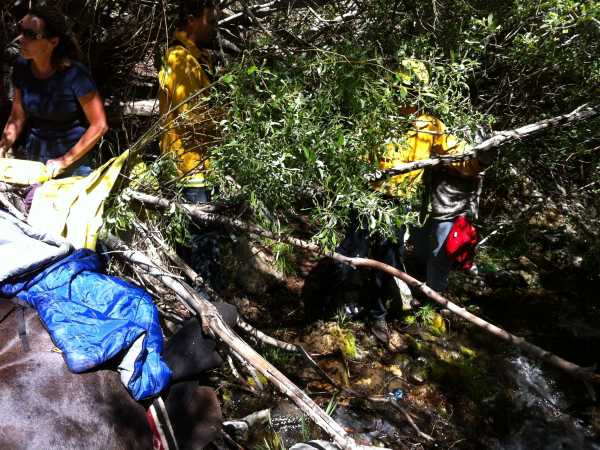
The relocation of some rocks helped reduce the flow of alpine water under the horse, however diverting the stream would have been time consuming and could have adversely impacted the extrication process, so it was not attempted.
There were no nearby roads. There was a hiking trail about 25 feet above the creek and debris would roll down the slope when people moved between the trail and the rescue site. Protecting the horse's eyes from dirt and debris became a priority.
Using a bra for eye protection.
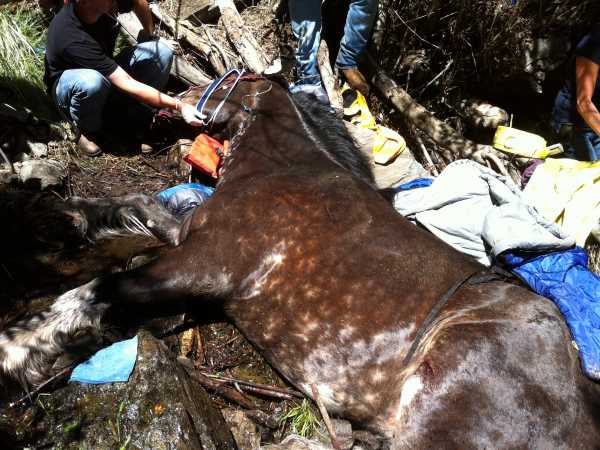
The media was showing up so one person was tasked with "public affairs" duties, satisfying inquiries and keeping reporters a safe distance away.
The great horse had fallen between a number of large boulders. He was generally calm and recumbent, but he would occasionally "fish flop." Padding was placed between his back and boulders until the work space could be enlarged.
Large horse wedged between boulders, padding protecting his back.
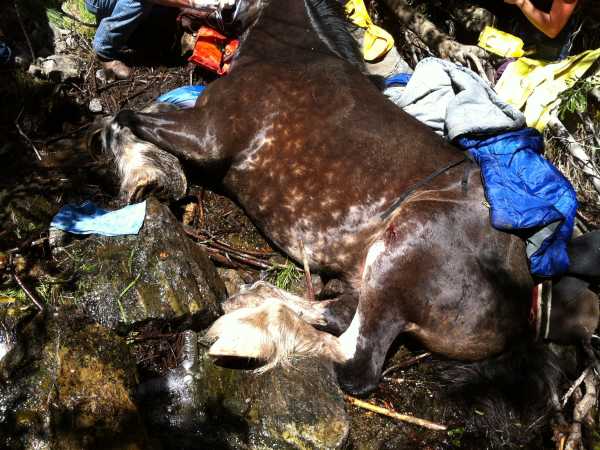
Once a proper work space was cleared (not an easy task) a Becker Sling was attached to the horse. While these activities were taking place one of the fire companies set up a monopod to provide a lift-assist for the horse.
Rigging the Becker Sling.
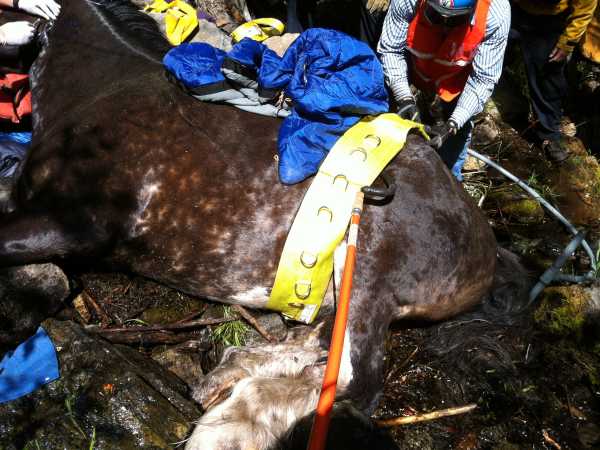
Securing the sling to the monopod.
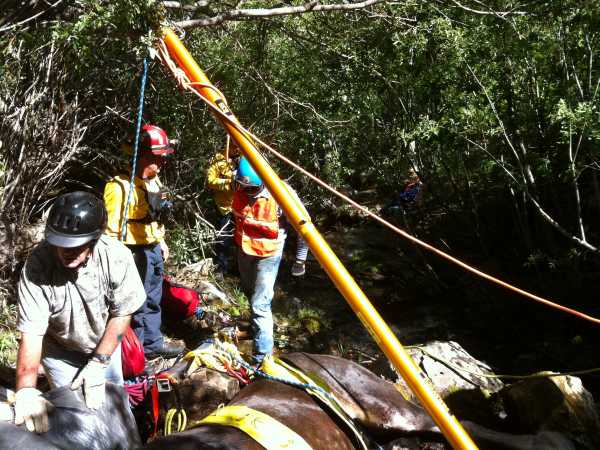
This view shows how dense the vegetation was.
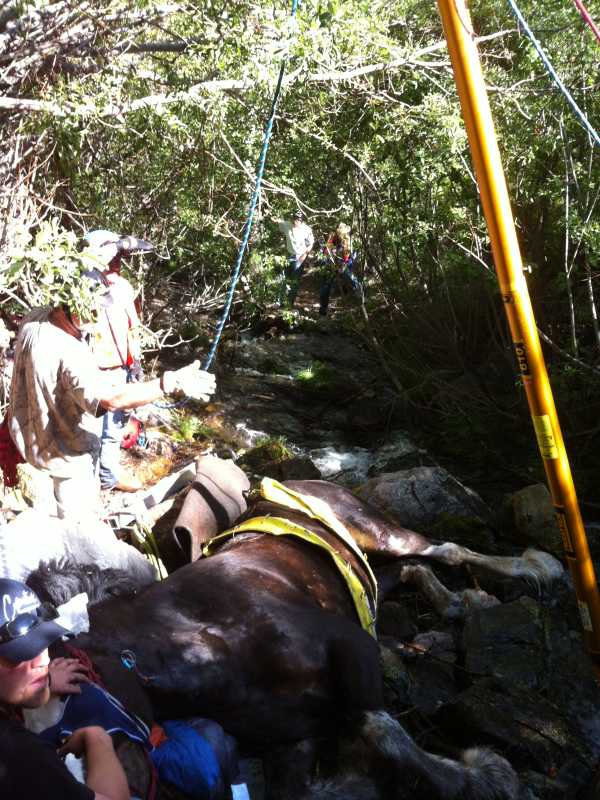
(At this point all hands went to work so there aren't any more images.)
The monopod wasn't strong enough to lift the horse, although it was sufficient to get the horse into the sternal position. After repeated failed attempts to get the horse to rise, a tazer was used to try to stimulate the horse's hindquarters. The horse still had insufficient strength to stand on his own and the lift assist from the monopod had to be carefully controlled so as not to break the device.
A determination was made to package the horse onto a Rescue Glide. There was no practical way to bring the horse up the steep, wooded canyon slope to the hiking trail so a decision was made to drag him down the creek to a Jeep trail. That solution created a whole new host of problems as tree branches had to be cut and boulders moved.
Fire, SAR and public works personnel cut branches and filled deep holes in the creek with relocated boulders and logs that had been sawed from the cut branches.
Two haul lines were attached to the "downstream" end of the Rescue Glide. A belay line with a brake was attached to the upstream end of the rescue glide. The horse and glide were positioned so that the horse's head remained in the uphill position.
Shortly after being secured to the glide the horse kicked out and broke his hobbles. His legs were again restrained by attaching webbing to the hobble cuffs.
The drag down the creek had to be carefully coordinated between the haul teams and the "brake operator" in order to get sufficient movement of the glide and its over one-ton load without it running away down the stream bed. Furthermore, immovable boulders and large trees required periodic changes of direction that also had to be carefully coordinated.
As the creek neared the Jeep trail it flowed into a small weir and a concrete collection box that was enclosed in a fairly long chain-link cage. There was a narrow dirt path alongside the cage barely wide enough for the Rescue Glide. This path had immovable boulders alongside it.
The fire department brought in heavy plywood shoring panels which were laid out to create a form of slide upon which the Rescue Glide could be dragged over. As the Rescue Glide cleared a panel, it was passed over the horse to be added to the panels laid down in front of the Glide. Eventually horse and Rescue Glide reached the Jeep trail.
After reaching the trail and following a brief rest where the horse was rolled over a couple of times, the big horse got to his feet and walked the length of the Jeep trail to a trailer waiting on a public street.
At the veterinarian's office the horse presented some neurological deficits and other issues, and the horse again could not get up. There was no Anderson sling in the region that could be used to keep the horse on his feet so a decision was made to euthanize him.
Nonetheless, well organized and well coordinated teamwork successfully removed the horse from this creek without exacerbating his injuries and providing him with an opportunity for recovery while at the same time protecting the city's water supply.
Post Script Comments
This particular incident illustrates the importance of constantly reassessing circumstances and the progress being made, regularly considering all options and alternatives, maintaining a cool head no matter how complex things become, and constantly following a logical decision making process. In this rescue the most logical approaches often hit dead ends so the situation had to be reassessed and a risk-benefit decision made as to what would be the next most potentially successful strategy.
In my experience these kinds of thought processes help prevent rescuers from becoming
overwhelmed and the operation breaking down or becoming chaotic.
Break the problem down to achievable goals. Order the goals by priority and/or by opportunity, depending on circumstances. Evaluate the success of each goal's attempt. Identify why a goal attempt failed. Adjust the strategy, then continue. Repeat the evaluation process and make adjustments until each key goal has been accomplished.
This material is intended for the use of the Technical Large Animal Emergency Rescue (TLAER) Facebook Group. TLAER is a trademark of Technical Large Animal Emergency Rescue.
| 